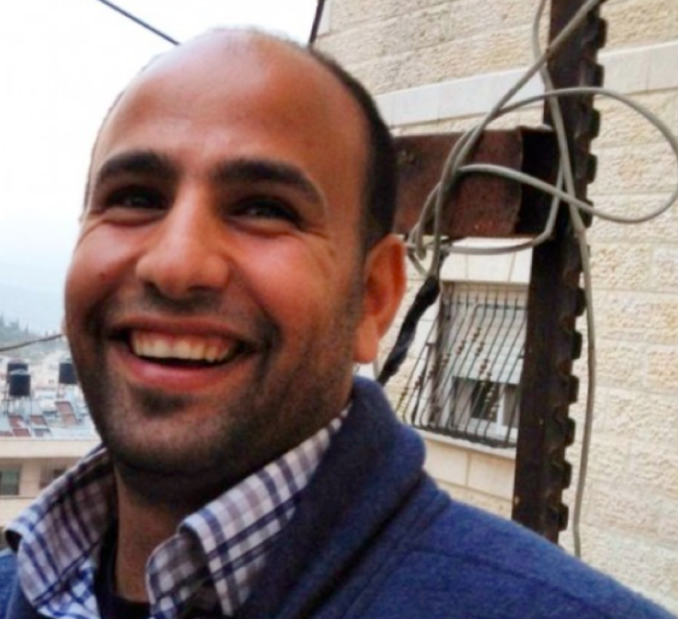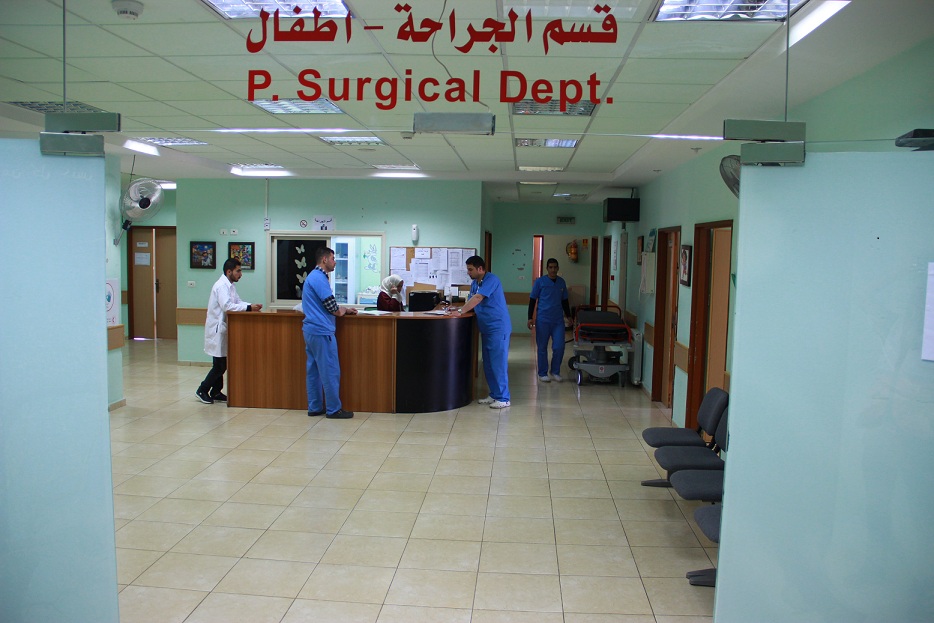SHUAFAT REFUGEE CAMP, WEST BANK — Palestinians refer to it as the “apartheid wall.” Parts of the concrete barrier crumbled two weeks ago, swept away by heavy rains to solidify a feeling shared by so many who live inside the wall: Everything here is broken.
About 400 meters from Pisgat Ze’ev, the largest Israeli settlement in East Jerusalem and a place considered illegal under international law, the stoning deaths take place daily in the Shuafat camp. Violent clashes erupt frequently, even before mass protests today here and in Gaza—over the re-location of the United States Embassy to Jerusalem—left at least 56 dead and thousands more wounded. Nearly everyone is armed and medical attention is sparse, a reality driven home by the recent protests. Fewer still are the emergency response and critical care teams, which are often delayed by congested roads and impassable Israeli checkpoints.
Baha Nababta headed the Peace Emergency Team, a volunteer-based emergency hotline, and was part of a group that responded to fires and medical emergencies. What he saw on a daily basis was the deteriorating care of the camp’s residents, his people. He often felt stretched thin as he rushed between snow-removal and fire calls, helping distressed elderly people and advocating for changes. It sometimes seemed a question of when, not if, life in the camp would eventually give way to chaos.
“The next intifada will come from here,” Nababta told the Times of Israel in 2015.
Less than a year later, on May 2nd, 2016, a motorbike assassin would shoot him seven times in the camp. Media reports from the time indicate that the attack might have been provoked by angry residents who felt Nababta was too cozy with the Israeli government. Friends loaded Nababta into a flatbed truck and drove him to the nearest checkpoint, choked with traffic at the apartheid wall circling the camp. He would die as he waited for the ambulance at the Israeli checkpoint, one of myriad prohibitive emergency medical barriers faced by refugees in the densely-packed settlement of some 80,000 inhabitants. He was 31.
In the wake of Nababta’s death, the Peace Emergency Team disbanded, further whittling the health, emergency, and rescue resources that are essential to life here. In the years to come, what services that existed for Palestinians in the West Bank would drastically dwindle. It has created an abysmal state of health care for Palestinian refugees in Israel, who can’t receive care for anything unless they are near death. Severely injured and chronically ill people languish.

(Screenshot: Peace Emergency Team)
“Everyone’s sick here,” says Abu Akram, who arrived to the camp in 1967 when there were roughly 500 families.
What treatment is available exists within a tangled system controlled by different government organizations both inside and outside the camp. Making matters worse, international aid for these clinics and health-care programs have recently faced cutbacks.
In January, the U.S. froze $65 million in funding, roughly half of the annual payment to the United Nations Relief and Works Agency for Palestine Refugees (UNRWA). In 2016, the U.S., the agency’s largest donor, provided $368 million toward the agency’s projects.
“It threw us for a bit of a loop, into a bit of a crisis mode,” says Scott Anderson, the director of operations for the UNRWA. “I am not sure what happened inside the government for this to take place, but at the end of the day this is the reality that we are faced with.”
Even as countries such as Qatar, Switzerland, and Turkey have granted funding to the agency since the Trump administration’s announcement of the cutback, the UNRWA still fell $446 million shy of its required funding. The Israeli foreign ministry has opposed the U.S. funding slash, fearing it will stoke the humanitarian disaster.
Meanwhile, health care in greater Jerusalem and Palestine is a confluence of government and non-government agencies, engendering a lack of coordination that imperils the health-care sector, according to a study published last year in BMJ Pediatrics Open, a clinical journal. The Palestinian Ministry of Health operates 24 of the 78 hospitals in Palestine, with tertiary and primary care providers, including the UNRWA, the Palestine Red Crescent Society, and private sector doctors, filling in treatment disparities.
The “UNRWA does have an important role in Palestinian health care now and in the future until a fair and just solution for the Palestinian refugees” is reached, says Dr. Bassam Y. Abu-Libdeh, the chief executive officer of Makassed Islamic Charitable Hospital in Jerusalem, which caters to Palestinians both inside and outside the camp. “If the health services by the UNRWA is interrupted or stopped, then this will increase the burden on the governmental health system.”
Founded in 1965 by the U.N. agency to house refugees from the Old City of Jerusalem, the Shuafat camp is particularly destitute. The U.N. clinic, located within a few hundred yards of the entry checkpoint into the camp, is among the programs that would shut down if the agency fails to raise more money.
“It will be a personal problem,” says Salim Anati, the senior medical officer for the Shuafat health center. “The big problem would be for the patients who would not be able to come for medical care and take their medication and treatment.”
During a tour, the clinic seemed barren, its walls a faded pink, and many plastic chairs were unoccupied. The clinic serves more than 2,000 refugees a month, according to Anati, many of whom receive treatment for hypertension, chronic heart problems, dialysis, prenatal care, and psychological counseling, among other services. Many patients come to fill prescriptions at the clinic’s pharmacy. There is a full-time staff of 16.
Morad Najam, 33, had come to the clinic on a recent morning to pick up a prescription. “I can’t get treatment on the Israeli side,” he tells me, “so I come here.” When asked whether he had any other options for treatment, he says, “At Kupat Holim, you have more services than here, but this prescription I get here.”

(Photo: Palestine Red Crescent Society)
The Kupat Holim clinic is nestled in a small building and is operated by one of Israel’s largest health-care providers. The waiting area is glitzy and gleaming, with doctors passing between rooms and several staff seated behind a counter.
It located precariously close to the U.N. clinic, a few yards away, which complicates matters for clinic officials. Nivin Jolani, the Kupat Holim daytime clinic administrator, says that, while the U.N. clinic assists residents with free or low-cost prescriptions, patients straddle both centers to their benefit.
“Patients get diagnoses here and they they get their medication from the UNRWA,” Jolani says, adding that many don’t return once they’ve received their prescription. “Because they get their prescriptions from the UNRWA, we don’t know if they’re getting check-ups, if their cholesterol levels are declining or climbing higher.”
She adds: “We have 50 clinics around here. All these clinics can’t give these people enough. The fundamental health-care framework just isn’t here.”
What persists in the camp is a sense of disillusionment in the system’s ability to care for them and their families.
“Any institution in the refugee camp is a failure,” says Hussan Alkam, a resident of the camp. “If you go to the UNRWA clinic seeking medicine you will not find it. If any UNRWA officials come to visit things will look perfect, but they are not.”
Palestinians find themselves faced with a Catch-22 of a most dire nature: Live outside of the retaining wall in the municipality of East Jerusalem, and have your health insurance revoked; or stay within the camps, and remain entitled to some form of decrepit governmental health care. But the choices outside the camp are myriad and even getting transferred to a hospital within an Israeli municipality could prove dangerous, with checkpoints delaying ambulances for hours.
“This is the $1 million question: Where to go and what to do?” Abu-Libdeh says.
Lands of Metamorphosis is a month-long column chronicling the social, cultural, and political paroxysms of the Middle East today.





